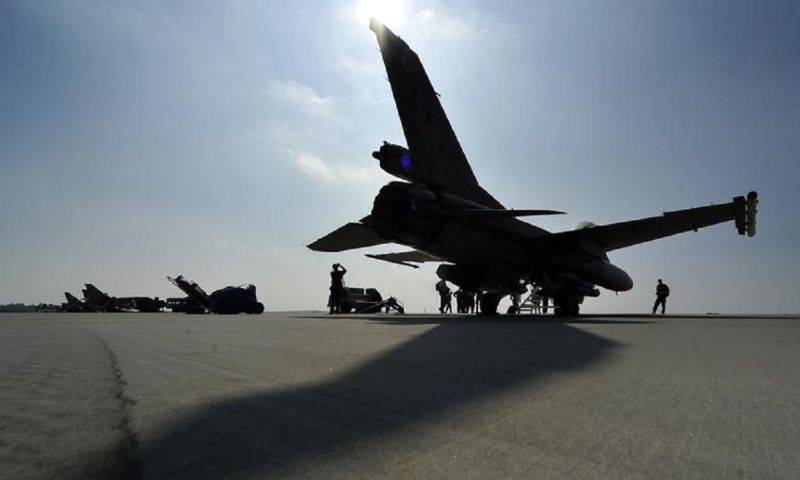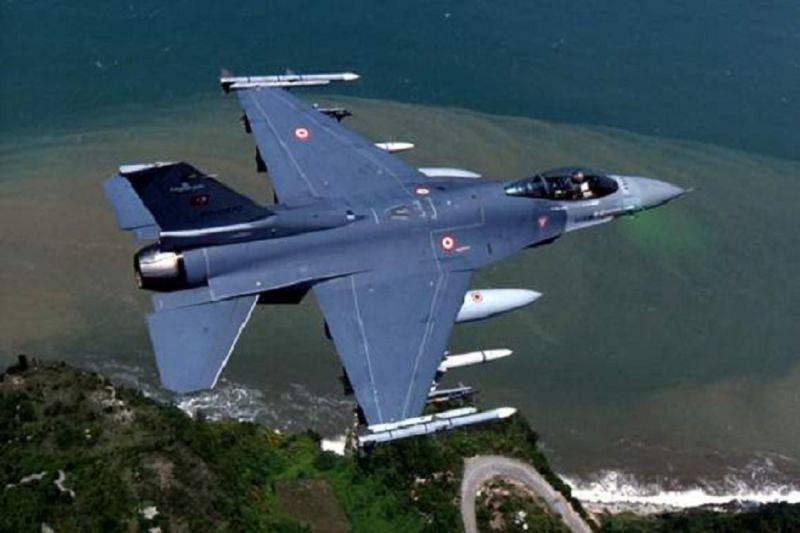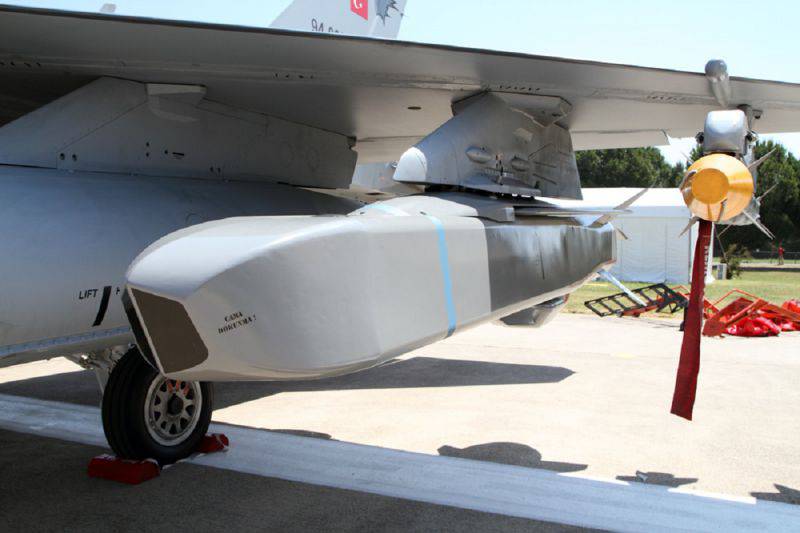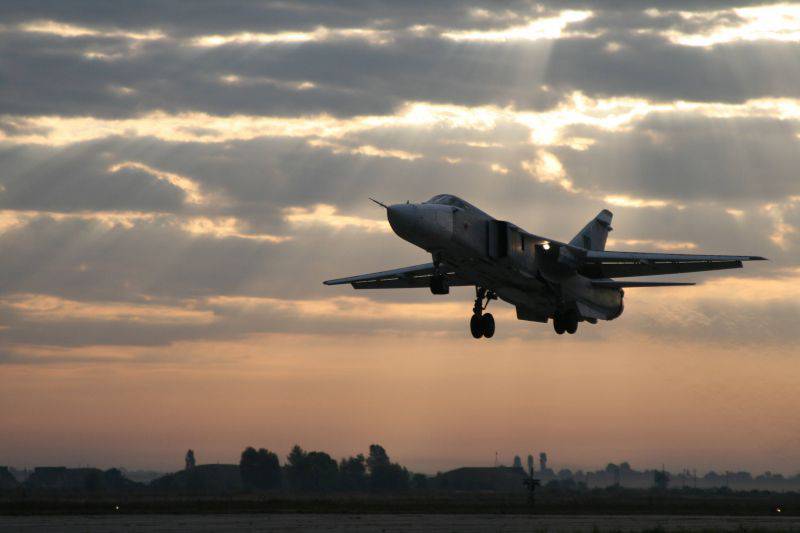The new concept of the Russian Aerospace Force of the Russian Federation will include a radical response to the Turkish aggression against the Su-24M
As is known, excessive tolerance towards those who quietly interact with our direct enemy behind our back can lead to a “backstab” at the most unexpected moment and into the most “weakened” zone. This is exactly what happened to the Su-24M tactical bomber of the Russian Aerospace Forces in the morning of November 24. Multipurpose F-16 Turkish fighter aircraft over the territory of the Syrian Arab Republic (in 1-2 km from the Turkish border) intercepted our Su-24M. The Russian defense ministry said it had used a short-range air-to-air missile with EKGSN (AIM-9 “Sidewinder”). As a result of hitting a missile defense system, presumably in the ZPS of the aircraft, a fire occurred in the power plant and damage to the bomber tail planes, which led to the crash of the vehicle. Two pilots were able to quickly eject, but as they approached the surface, Oleg Peshkov, a defenseless vehicle commander, was fired from a rifle gun. weapons, and on the ground Syrian turkomans-jihadists, who hold the northern regions of Lattakia province (near the Turkish border), cruelly punished him; the second pilot-navigator Konstantin Murakhtin could escape from the militants and was later rescued by the Syrian army together with the Russian special forces; and in an organized search and rescue operation, we also lost the young Marines fighter Alexander Pozynic. This tragic accident forced to completely rethink the tactics of application and security measures of the Russian Aerospace Force in the Middle East.

All factors confirmed by a criminal violation of all international standards of air borders protection are confirmed by ground-based radar equipment of objective control of Syrian air defense systems, downed Su-24 radio electronic equipment, as well as evidence provided by a rescued piloted navigator of the Russian Aerospace Force Konstantin Murakhtin. First, the operators of the Turkish air defense and air force did not make any warnings on any of the radio channels; secondly, the Turkish F-16C did not even align with our Su-24M and did not make any warning maneuvers, but immediately entered the rear hemisphere (tail) of our car; thirdly, they used a short-range air-to-air missile with ICGSN, which did not allow the aircraft’s radar exposure warning system (STR) to record the fact of a rocket attack and make an anti-missile maneuver. If during the attack the AIM-120C AMRAAM rocket was used, the Birch SPO would immediately detect the radiation of its active radar seeker and the pilots would receive at least a fraction of their time on the anti-missile maneuver, but the Turks would use the classic of the genre of real cunning cowards
Since the receipt of information on the interception of the Su-24M, many versions have been worked out, including intercepting with ground-based air defense systems of Turkey, but this version was thrown back, since the plane did not perform anti-aircraft maneuvers and flew at an altitude of 6 km. What does this indicate? Practically all modern MANPADS with passive IKGSN, including Igloo-S, RBS-90 or Stinger, which have a maximum interception height of 4000 m, could not even theoretically be able to intercept Su-24M, returning to Hmeymim airbase at an altitude of 6000 meters. It was not used for the “Drying” and “Hawk” or “Patriot” air defense missile systems, the missiles of which have PARGSN, and therefore the illumination of the MRLS of the complexes, which would force the pilots to maneuver, since the Birch SPO would certainly have responded to the radiation from the AN ground radar. / MPQ-50 and AN / MPQ-46 (SACO and RPN SAM "Hawk") or AN / MPQ-53 ("Patriot"). For this reason, there remains the only version confirmed by the Turks: the interception was performed by F-16. And this was done really suddenly and the most insidious method of "backstab." After the rescue of Konstantin Murakhtin, and his interview for the media, all of the above version was fully confirmed, and finally all the myths were dispelled on November 27, after the press conference of the Commander-in-Chief of the Russian Award Alliance V. Bondarev.
The Turks had already planned their aggressive action long before the combat operation of the Su-24M, and at the time of the flight of our aircraft to the combat zone, they had already started to escort it with the aid of ground-based airlift radar from the depths of Turkish territory, and the coordinates were reported to the F-16C pilots were in the air. And already on the return of the bombed-out car (with empty suspensions), the Falconas, with the AN / APG-68 radar off, on target designation of the same ground-based radar, they went unnoticed into the rear hemisphere of the Su-24M, following the base. Moreover, the F-16C link was supposed to approach in the following terrain mode (at extremely low altitudes), in order to avoid being detected by Syrian air defense systems on the ground, as well as on duty radar of the Russian Aeronautical Space Station at the Latakia air base, but the flaws were made: the flight took place on 2- 3 km, and the Syrian sight radars for a long time were bearing Turkish fighters, patrolling the area near the incident zone. The Turks were well aware of the fact that the Russian Air Force ARLO A-50 aircraft did not overtake Syria, and at that moment there was no escort of Su-30CM fighters. The fate of the Russian crew and aircraft depended solely on the prudence of the pilots and the Turkish leadership, but the “evil” prevailed, the Turks committed an aggressive act, the consequences of which did not take long to wait, and the reasons are probably already clear to almost any unbroken student.

Not only we felt the whole “friendliness” and adequacy of the Turkish leadership. Since 1996, Turkey has been using its F-16C to demonstrate ambition in the 4-mile zone of the airspace of most Greek islands in the Aegean Sea. Over the years of 20 over the sea there were many air battles with the Greek "Mirage-2000", in which both sides had losses. Practically every season is not complete without a violation of the Greek space by Turkish fighters, and sometimes a violation of the territorial waters of the warships of the Turkish Navy, to which Greece has to respond every time. At the same time, one can notice a disappointing fact: each penetration into the airspace of Greece occurs suddenly and from various air directions, which indicates the development by the Turks of a certain tactic for gaining superiority over the Greek Air Force over the Aegean Sea, which can be used both in the near future and in the long term, when NATO “disintegrates”, and possibly becomes obsolete, the trends of which are already visible today. Probably, the imperial habits of Turkey will continue to spread to the continental shelf belonging to Greece. And here Turkey is trying to position itself as a regional dwarf superpower with a tough and aggressive foreign policy.
The Turkish side did not go to such actions completely because of some fictional encroachment on the sovereignty of the country, which was not even close (after all, the plane had no equipment in 3-5 km from Turkey’s air border zone and did not perform dangerous maneuvers), but solely for the purpose of demonstrating dissatisfaction with the destruction of their most profitable oil business, which has been well organized in recent years with ISIS. Another of the main factors of such a criminal act is the mutually beneficial relations of Bilal Erdogan (the son of the Turkish president) with the IG, where the first well-known roof of the illegal distillation of cheap oil from the western part of Syria at the political level, which is emphasized even by European and American analysts.
The fact that NATO Secretary General Jens Stoltenberg recognized the Turkish version of the most truthful is a natural fact, but his facial expression and general confusion in answering questions from the media described the true picture in which not everything is as smooth as NATO is used to, and in the bloc itself completely ambiguous opinions, since one of the most important members of the alliance in the South-Eastern United Nations, namely Turkey, “led the whole block under the monastery”, which will cause an irreversible military-technical “boom” of our VKS in the Middle East, significantly weakening NATO positions. In fact, Turkey “scored a lush goal” at the gates of NATO for decades to come, all thanks to its own economic benefits.
Despite the fact that this “toad” the alliance will have to be swallowed, they will be able to turn this incident to their advantage. It is likely that this “action” can be repeated, and its goal will be to challenge a commensurate response from the Russian videoconferencing system, which later will lead to the blocking of the Bosphorus and an attempt to significantly complicate the logistics through the 720 PMO in Tartus for the general weakening of the videoconferencing RF in the Mediterranean. How to be here? And here, in any case, it is necessary to “show teeth”, and already on both sides of Turkey, it is possible that the force development of events. At the same time, escalation can occur even in the Black Sea region, where activists from the Crimean Medzhlis sponsored by the same Turks helped the Ukrainian pravosekah to plunge the whole peninsula into darkness, and Ukrainian artillery is concentrated in the Kherson region. Russia is now being pushed into direct confrontation, which will be more and more difficult to avoid. Well, you have to fight back!

Working through all the subtleties of the possible escalation of the confrontation with Turkey, it is necessary, first of all, to take into account the strongest sides of the Turkish Armed Forces. Despite the low level of development of the radar and optoelectronic industries, as well as the low level of development of the production of jet aviation engines, the Turkish company TÜBİTAK was able to develop its own sample of high-precision weapons, which poses a threat to both neighboring states and the Russian Aerospace Forces. The SOM tactical cruise missile (pictured) has a range of 200-300 km, with the possibility of increasing it to 2000 km, is capable of performing anti-aircraft maneuvers at low altitudes, has a low CEP and low radar signature, is equipped with an ARGSN and a satellite guidance channel. These characteristics allow the missile to hit command posts, radars, the most important elements of anti-aircraft missile systems, and airfields. These tactical cruise missiles are the most dangerous when they are massively used on difficult terrain, where to intercept such a strike it is necessary to pair several types of air defense systems in the amount of several batteries for each type, here you will not get off with one "Fort". A possible aggravation of the Turkish threat could serve as an impetus for further building up the air defense potential of the Russian flight contingent at the Syrian air base Khmeimim, as well as air defense in the Caucasus and Crimea
And the first significant steps made by our leadership today. Their economic part consists in the complete annulment of the Turkish Stream gas pipeline project that is strategically important for Turkey, the freezing of the Akkuyu NPP construction project, the complete cessation of cooperation in the tourism sector, as well as light industry; for example, Russian textile manufacturers have already proposed to the government to form a proposal to abandon Turkish clothing at the All-Russian level. In addition, a huge number of joint business plans will be stopped. All this will lead to billions in losses of the Turkish side. But this is not the most weighty measures that will be felt in full by the Black Sea "neighbor". Turkey will lose the previously existing levers of influence on the Crimea peninsula, where it has always had significant interests, since the ferry service between the banks will be completely interrupted, Sergey Aksenov said at the beginning of the week. There will be enormous difficulties in financing and other types of support for the Crimean Tatar Majlis, whose representatives, together with the Kiev hang-overs, bring great discomfort to the Crimea. Limiting the influence of the Turkish factor on the development of the Majlis in Crimea can be considered a tremendous advantage for the security of the region, since it has long been known about the punitive Dzhemilev Crimean battalion, acting against civilians and the army of New Russia in the Donbass, and about the participation of many of its members in ISIL, which, in turn, last week managed to declare Ukraine one of its enemies. It is here that the whole extremist-terrorist circle "Turkey-ISIL-Majlis-Ukraine" closes, in which Ukraine will once again be assigned the role of a "wild punching bag", supporting Turkey and the IG in absentia. It is from these "Trojans" that the Russian Federation will get rid of now.
The second, tougher counter-measures will manifest, of course, in the cessation of military cooperation at all levels of interaction between the defense ministry and the general staffs, a significant increase in the shock potential of the Russian space forces in the Turkish borders, as well as in the quite adequate so-called extension of the “permitted” when the lives of our compatriots or allies in the anti-Igil coalition are at stake.
Literally in the very first hours after the tragic incident with the Su-24M, the Ministry of Defense and the General Staff of the RF Armed Forces decided to send the newest air defense missile defense system to missile defense C-1164.5 air defense system, which now allowed to shoot down all air objects that are classified by means of air attack, threatening our videoconferencing.
The C-300F “Fort” air defense system onboard Moscow and C-400 will be able to close almost all airspace not only over the northwestern part of the SAR, but also over southern Turkey (Hatay, Adana, Mersin, Gazi provinces, etc.) d), which will no longer allow the Turkish Air Force to operate even at medium altitudes near the border with Syrian Latakia. All our attack units will now be escorted by multi-purpose Su-30CM and Su-27CM fighters, and Su-34, which will be able to stand up for itself in air combat, will be given priority in carrying out shock operations near the Turkish border. But there are some details of a tactical nature that show the insufficiency of the measures taken.
Today, most of the central and eastern parts of Syria continue to be controlled by the IS, and in particular, Raqqah, Homs and Deir ez-Zor. The range of C-400 and C-300F, located in the western part of the SAR, does not allow "to finish" to these lines, there is no possibility of placing ground-based air defense systems and near the front line near the city of Aleppo and other central cities, as there is a danger of losing promising air defense systems during the artillery and rifle battles with the IG, as well as the subsequent transfer of its element base to the West directly or through the Turkish side.
There is also a geographical factor. All shipborne radar and air defense missile systems, as well as ground-based air defense systems deployed in the littoral littoral zone of Latakia, do not have the ability to view the lower echelon of Syrian airspace as early as 30-35 km from the coast, as it is obstructed by the Jabel-Ansari mountain range with average altitudes over 1100 m. And no pseudo-coalition can guarantee that the Turkish Air Force, alone or with the help of our Western "friends", will not develop a next plan of action against our aircraft in low-altitude echelons, which often have units. air and army aircraft. And for this, it is necessary to deploy a strategic reconnaissance aviation, which will operate, accompanied by Su-35С, at a considerable distance from the most missile-dangerous sections of the theater of operations. We are talking about the A-50U long-range radar detection and control aircraft and the ORTR Tu-214Р aircraft, the use of which has never been discussed on the Syrian theater of operations. And these are the only machines capable of presenting the most realistic picture of a theater of military operations, with all its changes, which are threatening in nature.
The presence of A-50U aircraft equipped with an advanced radar complex "Bumblebee-2" will allow you to track any means of air attack (from fighter jets to subtle tactical missiles at ranges from 150 to 450 km) flying at ultra-low altitudes and over the most difficult mountainous terrain. That is, any dangerous approach of the enemy to any of the elements of the VKS will be immediately detected, and fighter aircraft will be used against the intruder. Neither C-400 nor "Fort-M" have air-based surveillance capabilities of the DRLO complex, since they have the concept of a radio horizon that depends on the terrain and the height of divisional radar equipment. For information, it is likely that A-50U are capable of providing target designation for the 9М96Х2 SAMs outside the radio horizon of the complex, i.e. over 40 km, which will allow C-400 to attack targets in any parts of Western Syria, and even beyond the mountains of Ansarius.
As for the Tu-214P, capable of conducting long-range optical and radio electronic reconnaissance of ground and underground targets, these planes can also play an important role in the information field of the Russian aerospace system in Syria. The “core” of the Tu-214P is the multi-frequency radar complex MRK-411, a two-sided AFAR which can not only detect and classify land and sea objects with the highest accuracy, but also work in the subsurface radiolocation mode, detecting the enemy’s underground infrastructure. For visual and infrared surveillance is used OESVR (optical-electronic aerial reconnaissance station) "Fraction". This aircraft would now be very relevant over the Syrian theater of operations, because immediately after the C-400 battery was being transferred to Hamim, the Turks immediately deployed armored forces and infantry to the border areas of Hatay province; I do not think that they would dare to move towards Latakia, but nobody could have even thought about a possible attack of the Turkish F-16 on our Su-24M! The Tu-214P can track any “movements” of the Turkish NE in the border areas, this will allow the VKS and ground forces in the SAR to act, if necessary, on pre-emption. The actions of any prospective aviation group relating to the network-centric component of the Air Force today must be supported by this kind of aircraft.
New food for thought for the sake of, I will cite some facts that few people managed to pay attention to. Their first side was announced on November 26 by Vladimir Putin at a joint press approach with Francois Hollande, immediately after negotiations with the French president. V. Putin admitted that tactical data on the actions of aviation of the Russian Aerospace Forces, which the Russian Federation is transmitting to the US Air Force in the region as part of data exchange to prevent air incidents, can be heard “right and left”, including Turkey’s main regional sponsor of terrorism. These data could help the Turkish Air Force to plan a cunning plan of attack on our front-line bomber. But that is not all.
The second side “surfaced” on the Western Internet a few days before the tragedy. 19 November online resource flightglobal.com published news about the start of duty in the Middle East region of the improved version of the American DRLO aircraft E-3G Block 40 / 45 of the AWACS system. The site reports that the plane was sent to South-West Asia (Western Asia); those. will act with one of the air bases of Saudi Arabia. This plane, even in the event of being on the ground, has a flying time to the southern borders of Syria for no more than one hour, and therefore can be quickly deployed and conduct long-range observation of Russian fighters and bombers from a distance of 500 - 600 km. The most powerful RFK with AFAR AN / APY-2 is able to simultaneously accompany 600 and more air targets, among which may be the entire operating group of the Russian Aerospace Forces. This aircraft can quietly provide information to the Turkish Air Force via the Link-16 channel, which is used by the Turkish army as a structural unit of NATO. This E-3G was sent to the Arabian Peninsula specifically for the purpose of monitoring the aircraft of our VKS, why don't we send such vehicles to the region?
The redeployment of the C-400 and RKR "Moscow" to Syria has already forced Ankara to stop flying over the SAR, cools all radical sentiments in the Turkish leadership and hatred from our co-driver Konstantin Murakhtin, who, like the entire flight crew of the Air Force, still recall everything that we had to go through 24 November. And the words of the US State Department about the “possible self-defense” of inhuman Turkomans who shot Oleg Peshkov’s pilot in the ejection seat once again confirm the former line of Washington, regardless of any human principles.
November 25 Russian VKS struck the Turkish “humanitarian convoys”, carrying new “trunks” and building materials for the IG and the so-called “moderate opposition” to the transshipment base in Azaz, this event marked the beginning of the end to the endless stream of cheap oil for Erdogan, therefore, new incidents may well be thought out in the “flat” minds of the Turkish elite. What they can come to will be very instructive for the “world community”, probably in the near future.

Information